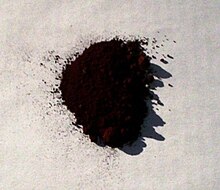Lead dioxide

Lead (IV) oxide, PbO2, also plumbic oxide and lead dioxide, is an oxide of lead, with lead in oxidation state +4. It has a molar mass of 239.2 g/mol.
When hydrated, it forms plumbic hydroxide or lead (IV) hydroxide, Pb(OH)4; given the formula, this is a mainly hypothetical compound.
Lead dioxide is amphoteric. Lead dioxide can dissolve in strong base to form plumbate ion, Pb(OH)62-. This can then form plumbate compounds. In acid conditions, it is typically reduced to lead(II) ion, Pb2+; lead(IV) ion, Pb4+, is not found in aqueous solution.
Lead dioxide is a somewhat strong oxidizer. With many reducing agents, it can produce lead(II) ion, Pb2+, or plumbous hydroxide, Pb(OH)2.
The most important use of lead dioxide is as the cathode of lead acid batteries.
